Saltwater fly fishing in tropical locations is a version of the sport where starting out properly is very important, and while I am not an expert, hopefully this advice will help you out should you decide to give it a try. As I write this I'm preparing for my third saltwater excursion so while not an expert hopefully I can help you along with a few things that I have learned. One word of caution, saltwater fly fishing is highly addictive. As one friend once put it after his first saltwater experience, "great, another hobby that I love but really can't afford".
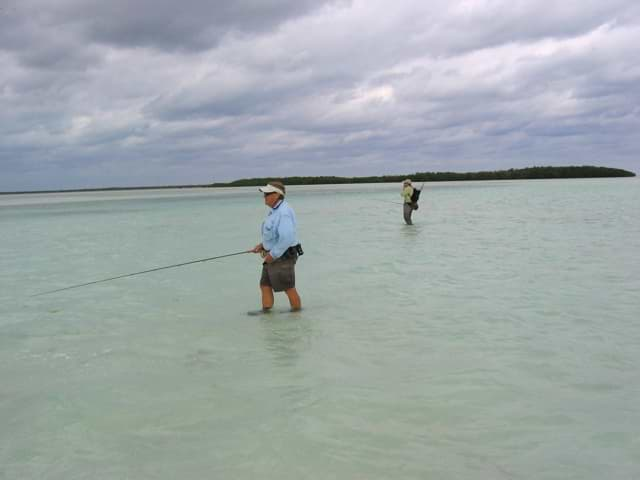
A saltwater fly fishing trip is a great way to break up the winter.
Much of the equipment used for freshwater fishing will be fine for the salt but if you can afford it there are some items that will make it more enjoyable. Lines are often looked at as less important than rods and reels but not so, especially in tropical saltwater locations. Saltwater fly lines are built with different cores and coatings that make them perform better in warmer air and water temperatures. Standard fly lines will get very limp and sticky in hot conditions.
There are many reels on the market that are designed specifically for saltwater, anodized aluminium or stainless steel parts and sealed drags make them corrosion resistant. This doesn't mean you can't use your trout reel for the salt, just that you must take care to rinse it thoroughly with fresh water after every use. The main things you need in a reel is a good drag and lots of capacity for backing. Fish in saltwater can strip off an amazing amount of line and backing in a short time, a fish in the ocean is one of three things, they’re either big, they’re fast or they’re food.
Rods are the one item that easily cross over from freshwater to salt and back again. Rods used for fishing large rivers with streamers, or casting large flies for pike will work well. The lodge or guiding company you're going with will have rod weight recommendations, listen to them. If you're going self guided search web sites for lodges/guides in the area for their recommendations.
Leaders and tippet for saltwater will vary with species but a general saltwater leader such as RIO’s "Saltwater Tapered Leader" will cover you for bonefish, permit, stripers and rooster fish. They also make a couple of specialty Tarpon leaders and "Toothy Critter" leaders if Barracuda are your target species. Regardless of whether your equipment is "saltwater" safe or not always give everything a good rinse daily if possible and at the end of your trip for sure.
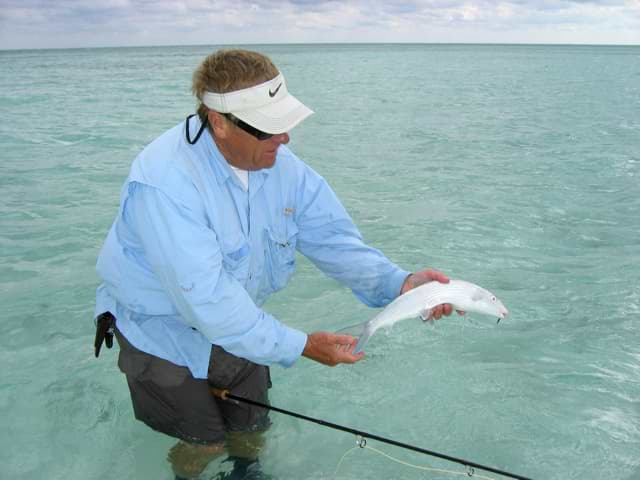
Even a small bonefish will strip off all of your fly line and many yards of backing in no time flat.
You will want to research your destination and target species to know what the best fly patterns you will be using. Most fishing stores will have a selection of the standard patterns, Crazy Charlie's, Gotchas, Bonefish Bitters to imitate shrimp, Merkin Crabs and other crab patterns, Clouser Minnows are all fairly easy to come by. On my first salt water fly fishing trip to Cuba my box was loaded with many patterns in all sizes and colours, out fishing whenever I showed my guide my fly box he always pointed to same fly, Crazy Charlies. Better safe than sorry though.

Make sure you have plenty of the recommended flies for the area you are headed to.
Making sure you're properly prepared with the right gear for the conditions you will be faced with can make or break a trip. A trip can be ruined very quickly with a bad sunburn or a cut foot. Protect yourself from the sun, it is intense on the water and while tropical breezes and boat rides from spot to spot will make you feel cool you still need the sun protection. Sunscreen goes without saying for any tropical vacation, fishing or not. Get a high SPF and make sure it's water resistant. Don't forget the back of your hands and if in sandals or bare feet, the tops of your feet. Always use sunscreen when on the water, regardless of the cloud cover and air temperature. There are many clothes on the market now aimed at sun protection, shirts, pants, hoodies, Buffs, hats and gloves that offer hi UV protection are all available. Designed to keep you cool and protect you from the sun at the same time.
If you are wading the flats on your trip you will want a good footwear, your wading boots from fresh water trout fishing will do but are often too heavy to make wading the flats enjoyable. There are many flats boots available, these are light weight yet tough enough to protect your feet from coral. Never assume the bottom will be the same from day to day, or even from hour to hour, one spot may have hard sand bottoms and the next one may be muddy and try to suck your boot off with every step. Usually a fanny pack type bag or a sling pack will do when wade fishing the flats, waterproof models are available and if you plan on doing a lot of saltwater flyfishing they are a good investment.
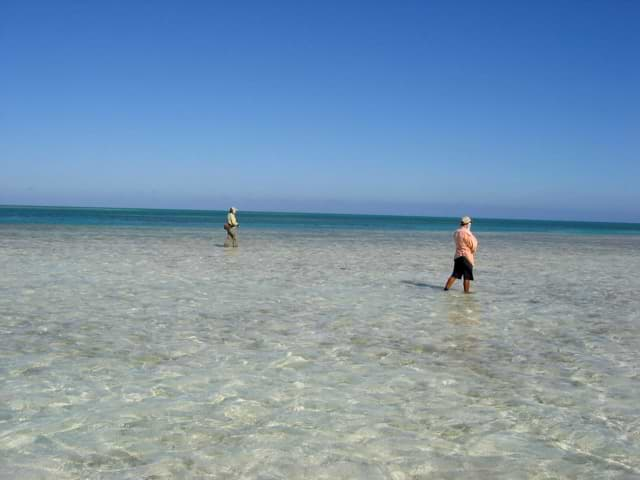
Wading boots or shoes and lots of sunscreen make wading the flats a very enjoyable experience.
Quite often you will be dealing with stiff monofilament, fluorocarbon and even wire so a good set of nippers or pliers with a good quality cutter are necessary. Also make sure to have a hook file along and use it, even on new flies, you're dealing with tough mouths and a sharp hook is necessary. Polarized sunglasses are a must, especially if you are fishing the flats. You will not be searching with your casts but rather spotting fish and then casting for them. Spotting them is all but impossible without sunglasses, even with them you won't see very fish your guide spots. Bonefish aren't called the "Ghosts of the Flats" for nothing.
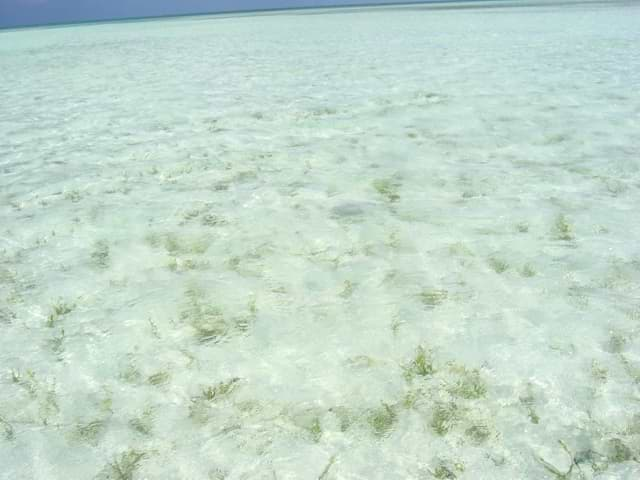
Bonefish blend right in with the bottom and that’s why they are called the Ghosts of the flats.
Practice your casting as much as you can before leaving home, you will be faced many different situations including wind, long casts, shorts cast and quick deliveries. Learn to change directions quickly and learn how far 30 ft., 40 ft. etc. is. Let your guide know you limitations right from the start so he can get you in a position that you can handle the casting distance. Once the cast is made and the fish eats is when a lot of trout fishermen have problems. With saltwater fish you have to learn to "strip set". Instead of lifting the rod tip upwards, a trout set, the angler pulls back with the line hand and moves the rod back parallel to the water. Lifting the rod tip will often pull the fly out of the fishes mouth and up out of the water, strip setting will get more hook ups and if the fish misses the fly this style of setting the hook will keep the fly in the water in front of him and often they will strike again.
Once you hook your first saltwater fish you’ll find out why people get addicted, a three pound bonefish will strip your reel of line and a 100 or so yards of backing in seconds flats, and will do this two or three times! Let the drag fight the fish and be prepared to reel or strip like crazy once he stops or starts running back towards you. A rod held at 30 - 45 degrees to the water will tire fish much quicker because their swimming motion pulls against the pressure of the rod. This also discourages jumping which is when a lot of fish are lost.
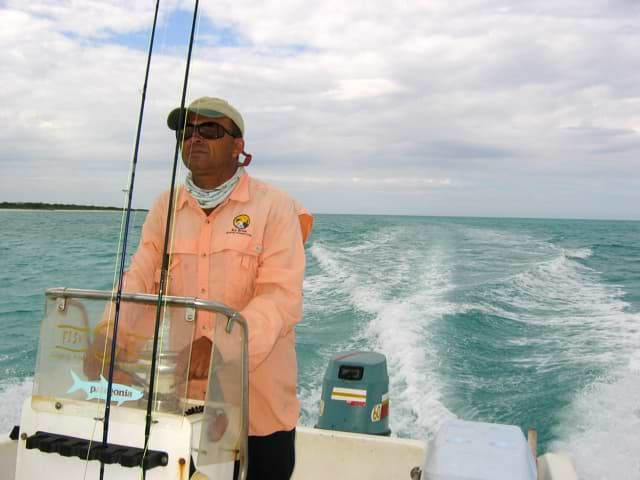
Using a guide will always pay off as they know the tides and where to be to take advantage of them.
If possible always hire a guide for salt water fly fishing excursions, especially for your first few trips. Their knowledge of the tides, location of the best fishing spots and most importantly their ability to spot fish, Bonefish aren't called the "Ghosts of the Flats" for no reason. If you are fishing with a guide, either wading the flats or in a boat, he will use the hands of the clock as reference when he spots a fish, and believe me he will spot many more fish than you will. When he says bonefish, 30 feet at ten o'clock it will help you hopefully spot the fish, even if you can't see the fish at least you can cast in the generally the right direction when he says to.
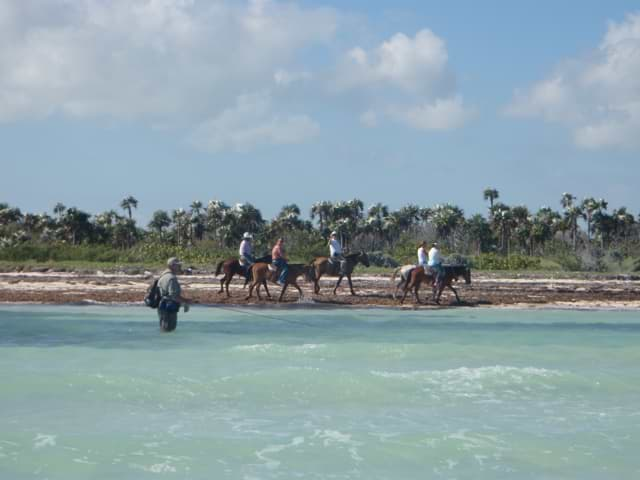
There is always something to do for the non-angler in most tropical saltwater destinations.
While salt water fly fishing excursions aren't cheap they do provide a good excuse to escape from cold winter climates to a tropical destination. If you're spouse doesn't fish but wants to come along there are usually lots of other activities to do and there is always lots of sun and sand for them to relax in. Saltwater fly fishing, give it a try this winter, I bet you will get hooked.


